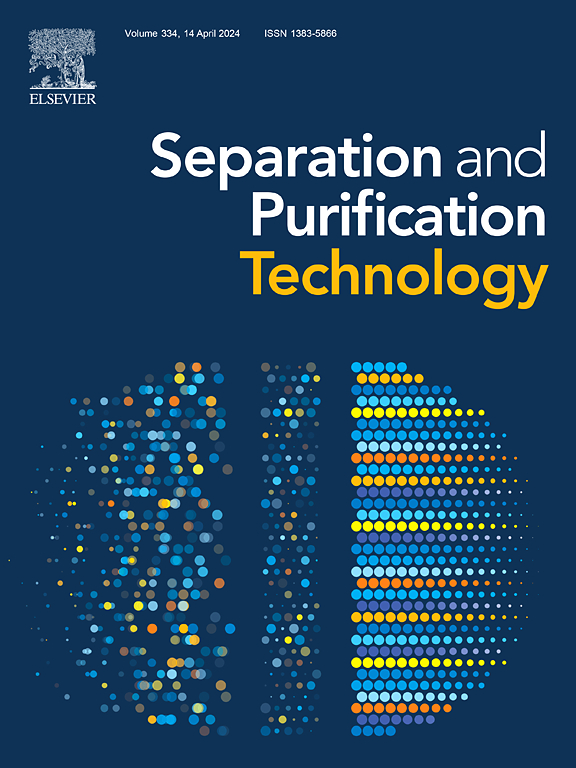Improvement mechanism of graphite flotation from kaolinite induced by laboratory synthesized polyaluminum chloride
IF 8.1
1区 工程技术
Q1 ENGINEERING, CHEMICAL
引用次数: 0
Abstract
The effect of laboratory synthesized polyaluminum chloride (PAC), which was prepared by alkali titration method, on the flotation performance of graphite was systematically studied in this work. Flotation tests using natural graphite ore demonstrated that PAC could enhance flotation yield while maintaining concentrate quality. Further flotation tests using artificial mixed graphite-kaolinite minerals demonstrated that the addition of PAC at around 30 mg/L can improve graphite recovery and separation efficiency, and has no significant negative effect on the loss on ignition in concentrate. The possible improvement mechanism of PAC on graphite flotation including water entrainment, slime coating, bubble-graphite attachment was revealed by characterization methods such as zeta potential measurements, focused beam reflectance measurement (FBRM), particle vision and measurement (PVM), single bubble loading tests and contact angle measurements. Zeta potential measurements show that PAC at 30 mg/L neutralized the negative charge on the surface of kaolinite, while graphite was positive charged. The real-time FBRM results show that the average chord length of kaolinite particles increased significantly when PAC concentration was 30 mg/L and decreased at PAC concentration of 90 mg/L, while graphite particles remained in a dispersion state. However, the PVM results indicated that the slime coating between kaolinite and graphite surface was aggravated when PAC was 30 mg/L and then got diminished at 90 mg/L. The single bubble loading tests and contact angle measurements proved that PAC at 30 mg/L significantly increased the attachment probability between bubble and graphite particles. Meanwhile, the contact angle of graphite remained stable without significant reduction, effectively maintaining the surface hydrophobicity of graphite and ultimately promoting graphite flotation recovery. This work is expected to provide theoretical understanding and technical support for graphite flotation by the adjustment of PAC concentration.


实验室合成聚合氯化铝对高岭石石墨浮选效果的改善机理
本文系统地研究了碱滴定法制备的室内合成聚合氯化铝(PAC)对石墨浮选性能的影响。采用天然石墨矿进行浮选试验,结果表明,PAC可在保证精矿质量的前提下提高浮选收率。进一步采用人工混合石墨-高岭石矿物进行浮选试验表明,添加30 mg/L左右的PAC可提高石墨的回收率和分离效率,对精矿的着火损失没有显著的负面影响。通过zeta电位测量、聚焦束反射测量(FBRM)、颗粒视觉与测量(PVM)、单泡加载试验和接触角测量等表征方法,揭示了PAC对石墨浮选的可能改善机理,包括水夹带、泥包覆、气泡-石墨附着等。Zeta电位测量结果表明,30 mg/L的PAC中和了高岭石表面的负电荷,而石墨则带正电荷。实时FBRM结果表明,PAC浓度为30 mg/L时,高岭石颗粒的平均弦长明显增大,PAC浓度为90 mg/L时,高岭石颗粒的平均弦长减小,而石墨颗粒仍处于分散状态。PVM结果表明,PAC为30 mg/L时,高岭石与石墨表面之间的黏液包覆加剧,PAC为90 mg/L时,黏液包覆减弱。单泡加载试验和接触角测量证明,30 mg/L的PAC显著增加了气泡与石墨颗粒的附着概率。同时,石墨的接触角保持稳定,没有明显降低,有效地保持了石墨的表面疏水性,最终促进了石墨的浮选回收。本研究有望为调整PAC浓度的石墨浮选提供理论认识和技术支持。
本文章由计算机程序翻译,如有差异,请以英文原文为准。
求助全文
约1分钟内获得全文
求助全文
来源期刊

Separation and Purification Technology
工程技术-工程:化工
CiteScore
14.00
自引率
12.80%
发文量
2347
审稿时长
43 days
期刊介绍:
Separation and Purification Technology is a premier journal committed to sharing innovative methods for separation and purification in chemical and environmental engineering, encompassing both homogeneous solutions and heterogeneous mixtures. Our scope includes the separation and/or purification of liquids, vapors, and gases, as well as carbon capture and separation techniques. However, it's important to note that methods solely intended for analytical purposes are not within the scope of the journal. Additionally, disciplines such as soil science, polymer science, and metallurgy fall outside the purview of Separation and Purification Technology. Join us in advancing the field of separation and purification methods for sustainable solutions in chemical and environmental engineering.
 求助内容:
求助内容: 应助结果提醒方式:
应助结果提醒方式:


